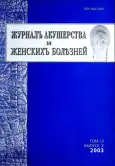Endoscopic transcervical fallopian recannulation for infertility treatment
- Authors: Kira E.F.1,2, Bezhenar V.F.1,2, Liatoshinskaia P.V.1,2
-
Affiliations:
- National Medical and Surgical Center of the Ministry of Health of the Russian Federation
- Russian Military Medical Academy
- Issue: Vol 52, No 3 (2003)
- Pages: 22-27
- Section: Original study articles
- URL: https://journals.rcsi.science/jowd/article/view/88959
- DOI: https://doi.org/10.17816/JOWD88959
- ID: 88959
Cite item
Full Text
Abstract
Endoscopically-guided transcervical fallopian recannulation for the treatment of proximal tubal occlusion was performed in 27 patients. 31/38 (81,6±6,3%) tubes were cannulated successfully. Of 25/27(92,6±5,0%) patients at least one tube was successfully treated, the perforation rate was 3,7% (1 patient) and there were 12 pregnancies (48,0%). This procedure has the advantages of visualization of distal tubal segments and uterine cavity. The prognosis is poor when additional distal disease is present.
Full Text
##article.viewOnOriginalSite##About the authors
E. F. Kira
National Medical and Surgical Center of the Ministry of Health of the Russian Federation; Russian Military Medical Academy
Email: info@eco-vector.com
Department of Obstetrics and Gynecology named after AND I. Krassovsky
Russian Federation, Moscow; Saint PetersburgV. F. Bezhenar
National Medical and Surgical Center of the Ministry of Health of the Russian Federation; Russian Military Medical Academy
Email: info@eco-vector.com
Department of Obstetrics and Gynecology named after AND I. Krassovsky
Russian Federation, Moscow; Saint PetersburgP. V. Liatoshinskaia
National Medical and Surgical Center of the Ministry of Health of the Russian Federation; Russian Military Medical Academy
Author for correspondence.
Email: info@eco-vector.com
Department of Obstetrics and Gynecology named after AND I. Krassovsky
Russian Federation, Moscow; Saint PetersburgReferences
Supplementary files









